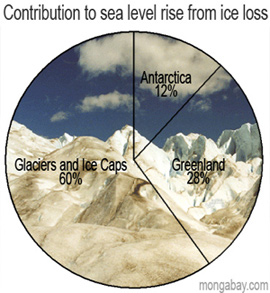Water held in man-made reservoirs is masking the true extent of sea level rise from melting ice and thermal expansion, report scientists writing in the journal Science. The researchers, from the National Central University in Taiwan, calculate that sea levels would be 30 mm (1.2 inches) higher without water stored behind dams.
The findings are significant in that they increase by a third the annual rise in sea levels observed since 1961, from 1.8 mm to 2.4 mm. Rising sea levels have been attributed to thermal expansion of warming sea water and melting of polar ice caps and glaciers. According to the University of Colorado at Boulder’s Institute of Arctic and Alpine Research, about 60 percent of total global sea rise from ice loss can be attributed to glaciers and ice caps, 28 percent from Greenland, and 12 percent from Antarctica.
 |
Last year the United Nations Intergovernmental Panel on Climate Change (IPCC) projected that global warming would cause oceans to rise 18 to 59 centimeters (7 to 23 inches) by 2100, though some scientists said the estimates were too low due to other sources of melt. Their criticism found support in the latest study which suggests that IPCC figures are indeed underestimates.
In its 2007 report, the IPCC said it could account for only 1.1 mm of the observed annual sea level rise of 1.8 mm from 1961 to 2003. It attributed 0.4 mm of rise to thermal expansion and 0.7 mm to melting ice. Overall global average sea level rose about 17 centimeters last century.
The Taiwanese researchers used the International Commission on Large Dams’ World Register of Dams to calculate the volume of water — some 10,800 cubic kilometers (2,600 cubic miles) — that is stored in more than 29,000 reservoirs worldwide. They then used data on when dams were built to calculate annual sea level rise had water not been retained by dams. They found that sea levels would have climbed by an “essentially constant” 2.46 millimeters per year over the past eight decades.